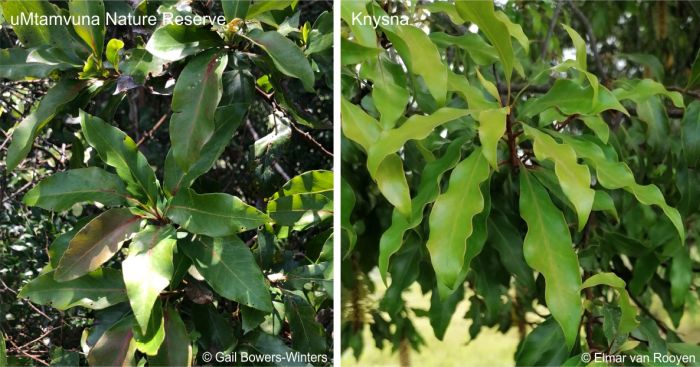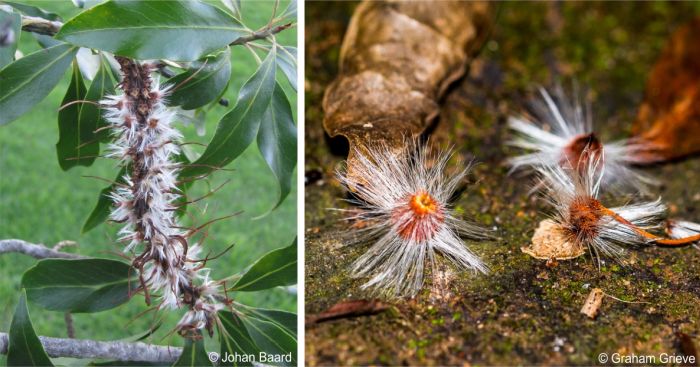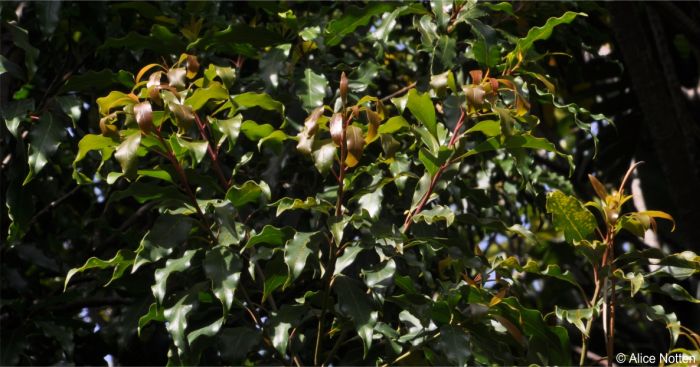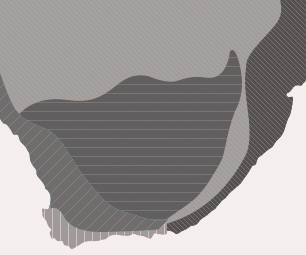Faurea macnaughtonii
Faurea macnaughtonii E.Phillips
Family: Proteaceae
Common names: Terblans, Terblans beechwood, Egossa beech, Macnaughton's beech (Eng.); terblans, terblanshout, egossabeukehout, bosboekenhout, rooiboekenhout (Afr.); icuba-lethole, isafo, isafu, isafa, isisefu, isiqwane, umkhubane (isiXhosa); isisefo, isiqalaba (isiZulu)
SA Tree No: 74
Introduction
Rising tall and graceful in South Africa’s deep forests, Faurea macnaughtonii is a rare evergreen whose glossy leaves, sweetly scented summer blooms, and textured bark tell the story of a beautiful tree.

Description
Description
A tall, evergreen, forest dwelling tree of around 20-25 m in height. The thick, grey bark is smooth in younger trees, becoming progressively dark and rough in mature specimens. Glossy green leaves are leathery in texture, with defined wavy margins. They are variable, with young trees and coppice growth being lanceolate and mature leaves being shorter and broader, obovate to elliptic-obovate. The leaves are held on a short, reddish stalk, 10 mm long. Young growth has a reddish hue.

Creamy white or light pink, sweetly scented flowers appear in summer (Dec.–Feb.) on dense, pendent spikes extending 150 mm long. The fruit is a small brown nutlet covered in long white to yellowish hairs and can be observed from summer into winter (Feb.–Jun.).

Faurea macnaughtonii is often confused with Faurea galpinii. The difference between the two species being that the latter has an erect inflorescence and narrower leaves than those of Faurea macnaughtonii.
Conservation Status
Status
Faurea macnaughtonii is a Rare species, according to the Red List of South African Plants. It has a wide range but a small and fragmented population, with known subpopulations having fewer than 100 mature individuals. The largest recorded subpopulation occurs in the Knysna forest in the Garden Route district. Although there are no severe threats to this species, there are isolated instances of forest degradation caused by uncontrolled wildfires, wood harvesting and subsistence farming.

Distribution and habitat
Distribution description
Faurea macnaughtonii is distributed in the Western Cape, Eastern Cape, Kwazulu-Natal, Mpumalanga and Limpopo provinces of South Africa, and in Eswatini. This species can be found from the Wolkberg in the Limpopo province, southwards to the Amathole mountains of the Eastern Cape and the Knysna forest in the Western Cape. Faurea macnaughtonii is a forest tree occurring deep in mature forest and forest margin, in scarp, mistbelt, montane and Afrotemperate Forest from near sea level up to 2 000 m in altitude. This is a semi-hardy tree which can tolerate light frost.

Derivation of name and historical aspects
History
The genus name Faurea was given in honour of William Caldwell Faure (1822–1844), a South African soldier and botanist who was killed in India while working for the East India Company. The specific epithet macnaughtonii is in honour of Colin Beddoes McNaughton who was a conservator of forests from 1889 until 1909. The common name Terblanz was given because it was first discovered and the wood worked by a person called Terblanz. The Afrikaans names boekenhout and beukeboom, meaning beech, were given by woodcutters for whom the timber resembled that of the beech, Fagus sylvatica. This common name was first given to Rapanea melanophloeos, and later also to species of Faurea.
Faurea is a genus of 16 species of forest or woodland trees and shrubs from Africa and Madagascar. Five of these species occur in South Africa, Faurea galpinii, Faurea macnaughtonii, Faurea saligna, Faurea rochetiana and Faurea recondita. Interestingly Faurea is the only member of the Proteaceae occurring in Africa to not be centralized to the Fynbos Biome of South Africa.
Ecology
Ecology
The sweetly scented flowers of Faurea macnaughtonii are pollinated by bees. The seeds are dispersed by wind and are often blown off as soon as they ripen, and fall to the forest floor.

Uses
Use
The wood is hard and heavy, dark brown, beautifully grained and sweet smelling, and has been used to make furniture or burned for furniture. The bark is reputed to have medicinal properties and is used in traditional medicine.
Growing Faurea macnaughtonii
Grow
Faurea macnaughtonii is not well-known in cultivation and has not been propagated at Kirstenbosch for many years. The trees in the Garden were collected as seedlings from the forest floor in the Gouna forest in Knysna in 1978 and grown on in the nursery for several years. If seeds can be obtained, they should be sown fresh, in spring or early summer. Seedlings and saplings are best grown on in light shade, in well-drained, acidic, humus-rich soil and kept moist. Trees should be planted into a shady or semi-shady, well-watered spot that is protected from strong wind.
References
- Baard, J. 2012. Observation of Faurea macnaughtonii, Gouna forest, WC. iNaturalist. Online. https://www.inaturalist.org/observations/10799245.
- Boon, R. 2010. Pooley's trees of eastern South Africa, a complete guide. Flora & Fauna Publications Trust, Durban.
- Bowers-Winters, G. 2023-Mar. Observation of Faurea macnaughtoni, uMmtamvuna Nature Reserve. iNaturalist. Online. https://www.inaturalist.org/observations/150405133.
- Coates Palgrave, K. 1983. Trees of southern Africa. Struik, Cape Town.
- De Winter, B., De Winter, M. & Killick, D.J.B. 1966. Sixty-six Transvaal trees. Botanical Research Institute Department of Agricultural Technical Services, Pretoria.
- Glen, H. 2004. Sappi what’s in a name?. Jacana Media (PTY) Ltd. Johannesburg.
- Grieve, G. 2025. Observations of Faurea macnaughtonii. iNaturalist. Online. https://www.inaturalist.org/observations?taxon_id=192380&user_id=graham_g&verifiable=any.
- Gunn, M. & Codd, L.E. 1980. Botanical exploration of southern Africa. Balkema, Cape town.
- Hutchings, A., Scott, A.H., Lewis, G. & Cunningham, A.B. 1996. Zulu medicinal plants: an inventory. University of Natal Press, Pietermaritzburg.
- Mhlongo, N.N. & Hankey, A. 2015. Faurea galpinii E.Phillips (Proteaceae). PlantZAfrica. Online. https://pza.sanbi.org/faurea-galpinii.
- Plug, C. 2020. McNaughton, Mr Colin Beddoes. S2A3 Biographical Database of Southern African Science. Online. https://www.s2a3.org.za/bio/Biograph_final.php?serial=1800.
- Rebelo, A.G. 2001. Proteas. A field guide to the proteas of southern Africa. Fernwood Press, Vlaeberg, Cape Town.
- Rebelo, A.G., Mtshali, H. & von Staden, L. 2020. Faurea macnaughtonii E.Phillips. National Assessment: Red List of South African Plants. https://redlist.sanbi.org/species.php?species=796-2.
- Smith, C.A. 1966. Common names of South African plants. Memoirs of the Botanical Survey of South Africa No. 35. Government Printer, Pretoria.
- Van Rensburg, A.D. 1977. Plant more indigenous trees. Veld & Flora 63(4):4–7.
- Van Rooyen, E. 2021-Mar. Observation of Faurea macnaughtonii, Harkerville, WC iNaturalist. Online. https://www.inaturalist.org/observations/72363271
- Wiles, W. 2017-Mar. Observation of Faurea macnaughtonii, Jonkersberg, Gouna area, WC. iNaturalist. Online. https://www.inaturalist.org/observations/11283164.
Credits
Siphesihle Precious Sibiya and Alice Notten
Kirstenbosch National Botanical Garden
October 2025
Acknowledgements: The authors thank Graham Grieve, Elmar van Rooyen, Johan Baard, Gail Bowers-Winters and Wendy Wiles for making their images of Faurea macnaughtonii available via iNaturalist.
Plant Attributes:
Plant Type: Tree
SA Distribution: Eastern Cape, KwaZulu-Natal, Limpopo, Mpumalanga, Western Cape
Soil type: Loam
Flowering season: Early Summer
PH: Acid, Neutral
Flower colour: White, Pink, Cream
Aspect: Shade, Morning Sun (Semi Shade), Afternoon Sun (Semi Shade)
Gardening skill: Challenging
Special Features:
Horticultural zones









Rate this article
Article well written and informative
Rate this plant
Is this an interesting plant?
Login to add your Comment
Back to topNot registered yet? Click here to register.